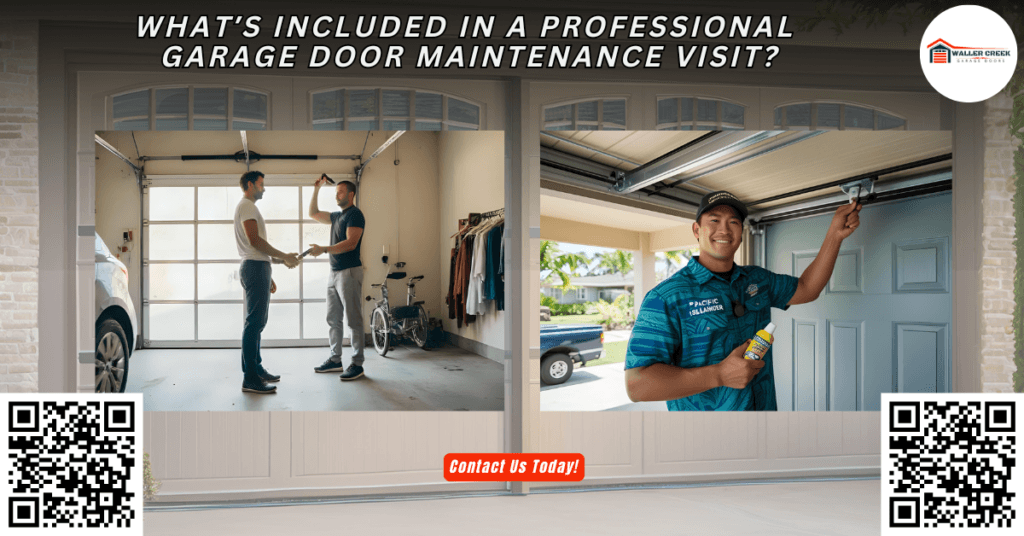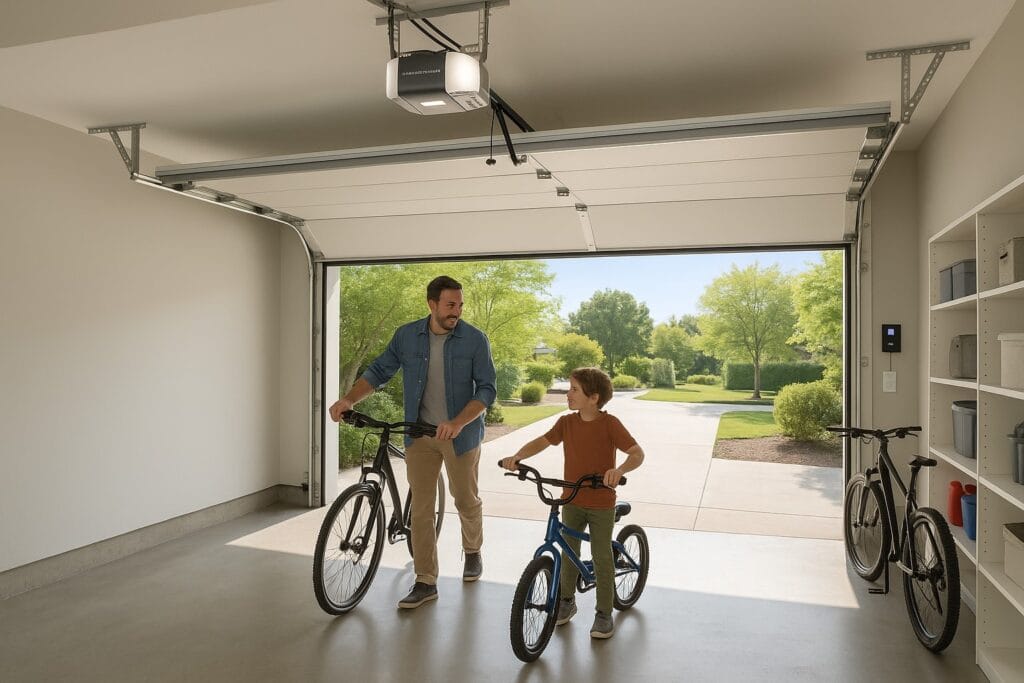What’s Included in a Professional Garage Door Maintenance Visit?

It was a hot summer morning in Austin, TX, when a homeowner from the Cherrywood neighborhood called Waller Creek Garage Doors. Their garage door had suddenly jammed halfway down, leaving their vehicle and belongings vulnerable. After years of skipping maintenance, the rollers had worn unevenly, and the opener’s chain was off track. If they had scheduled regular garage door maintenance, a routine inspection and lubrication could have caught the early warning signs and saved time, stress, and costly emergency garage door repairs.
According to national statistics, garage doors are the largest moving object in a home and are typically used multiple times a day. That’s over 1,500 cycles a year for the average family. Despite this heavy usage, many homeowners overlook garage door maintenance until a major problem arises. The Family Handyman recommends a detailed garage door tune-up at least once per year to prevent issues like rust, misalignment, or worn-out torsion springs.
Professional garage door maintenance is not just about convenience; it’s a critical service that ensures the safe, smooth operation of your garage door system. In this step-by-step guide, we’ll explain everything included in a maintenance visit, why each task matters, and how it benefits your home and your family in the long run.
Why Garage Door Maintenance Matters
A properly functioning garage door is essential for your home’s safety, security, and energy efficiency. Garage doors and their many components, including garage door openers, springs, cables, rollers, hinges, and tracks, undergo constant wear and tear. Without maintenance, these vital parts degrade, increasing the risk of failure.
Garage door maintenance prevents small issues from becoming major hazards. A broken spring or misaligned track can cause your door to jam, fall unexpectedly, or refuse to open. This puts your vehicle, storage items, and most importantly, your family at risk. Regular servicing also ensures your door’s safety features, such as the auto-reverse sensor system, are functional.
Other reasons maintenance matters:
- Prevents garage doors from detaching and falling
- Keeps your opener running smoothly and quietly
- Preserves your warranty with some manufacturers
- Enhances your home’s curb appeal
- Reduces energy loss with effective weather sealing
Homeowners who invest in annual maintenance often avoid costly emergency service calls and extend the overall lifespan of their garage door system by several years.

Thorough Inspection of All Garage Door Parts
The first step in a professional maintenance visit is a complete inspection of every part of your garage door system. Technicians take a methodical approach, beginning with the largest components and moving down to nuts, bolts, and fasteners.
Key areas include:
- Garage door panels: We check for warping, peeling paint, dents, or signs of water damage. On steel doors, we watch for rust spots. On wood doors, we inspect for cracks or splitting due to weather.
- Springs: Our technician checks both torsion and extension springs for signs of wear, elongation, or corrosion. Springs are essential for lifting the heavy weight of the door.
- Rollers: Garage door rollers must spin smoothly without resistance. We inspect for wear, chips, or cracked wheels.
- Hinges: Hinges that hold door panels together are examined for looseness, rust, and alignment.
- Cables: Worn or frayed lift cables are a hazard. We assess cable tension and attachment points.
- Garage door tracks: We verify alignment, ensure bolts are tight, and inspect for bends or gaps.
- Garage door opener: We observe motor behavior, listen for grinding sounds, and test the wireless remote.
- Arm bar and top rail: These pieces connect the opener to the door. They must be secure and straight.
Every component, from large torsion springs to small roller brackets, is inspected with safety and longevity in mind.
Balance Testing and Spring Adjustment
Your garage door relies on spring tension for safe operation. Springs lift most of the door’s weight, making it feel light to the garage door opener. Without proper tension, the door becomes unstable.
Here’s how we test and adjust:
- Disconnect the door from the opener using the release handle.
- Manually lift the door to mid-height and observe whether it stays in place.
- If the door falls, the springs are likely under-tensioned. If it rises, they may be over-tensioned.
- Our technician uses winding bars and a socket wrench to safely adjust torsion springs.
- We inspect spring anchor brackets and center bearings for stress or wear.
This balance test is vital for preserving your opener’s motor and preventing excess strain on tracks and rollers.
Lubrication of All Moving Parts
One of the most critical tasks in any garage door maintenance visit is proper lubrication. Without the right lubricant, metal-on-metal contact leads to noise, rust, and part failure.
We use white lithium grease and spray lubricants designed specifically for garage doors. These lubricants protect against moisture and allow for quiet operation year-round.
We lubricate:
- Torsion springs: Coating the coils prevents rust and reduces friction.
- Hinges: Ensures each panel swings freely without squeaking.
- Rollers: Especially if they’re metal. Nylon rollers with no bearings may not require lubrication.
- Pulleys and bearings: Enhance spinning motion and load support.
- Top rail and arm bar: Allows for smooth motor engagement.
- Chain or screw drive: If not factory-lubricated, these systems benefit from added grease.
We never over-lubricate, as excess grease attracts dirt and dust. Proper lubrication is the secret to a smooth, quiet, and efficient garage door.
Cleaning the Tracks and the Surrounding Area
Tracks guide the rollers and control the path of the door. If they become dirty, misaligned, or damaged, your door can derail or bind.
Our cleaning process includes:
- Vacuuming debris, leaves, or cobwebs
- Wiping the track interior with a dry cloth or a damp sponge
- Avoid any greasing of the track surface to prevent gunk buildup
- Checking for rust, especially near welds or screw holes
- Inspecting the junction between horizontal and vertical track sections
Proper track care ensures your door glides like new and reduces wear on garage door rollers.
Tightening Hardware and Fasteners
Every vibration from opening or closing can loosen parts of your door over time. If ignored, this leads to rattling, sagging panels, or even catastrophic failure.
Our maintenance technician will:
- Tighten all bolts and nuts using a socket wrench or ratchet
- Re-secure roller brackets, hinge mounts, and track fasteners
- Inspect and replace stripped screws or worn hardware
- Check arm bar and opener mounting brackets for a secure fit
This process stabilizes the entire system and prevents long-term issues from developing.
Garage Door Opener System Check
Garage door openers are now smarter, quieter, and more reliable than ever. But they require attention too.
We inspect:
- Motor performance for smooth startup and shutdown
- Chain or belt tension (especially on Stealth Drive Connect systems)
- Remote control battery and range
- Keypad function and connectivity
- Wall control button responsiveness
- Backup battery status and health (if installed)

We also test manual override functionality using the release handle to ensure homeowners can open their doors during a power outage.
Safety Features and Sensor Testing
Garage door safety sensors are located a few inches off the ground on each side of the door. These infrared beams prevent the door from closing on children, pets, or objects.
During maintenance, we:
- Clean the sensor lenses
- Ensure brackets are aligned and tightly mounted
- Test beam interruption response
- Confirm door stops and reverses when an obstruction is present
- Check wires for damage or wear
We also verify your opener complies with modern safety codes for the auto-reverse feature and alert you to any upgrades needed.
Weather Stripping and Insulation Check
Drafty garages raise your energy bills and expose your belongings to weather extremes. We inspect your weatherstripping and insulation.
Our technician checks:
- Bottom rubber seal for cracks or flattening
- Side and top vinyl seals for shrinking or separation
- Garage floor alignment and door gap
- Integrity of any internal insulation on door panels
Replacing worn seals helps you keep the garage dry, warm, and energy-efficient year-round.
Recommendations and DIY Tips
Once all inspections and servicing are complete, we share an easy-to-read summary of:
- Immediate repair needs
- Preventative maintenance suggestions
- Upgrade options (like smart openers or quiet belt drives)
For homeowners, we offer DIY tips:
- Lubricate parts every 3 months
- Wipe tracks monthly with a dry cloth
- Use a flashlight to check the cable condition
- Keep the garage door clear of stored items
- Avoid DIY spring or cable replacement due to injury risk
These small efforts make a big difference between a well-working door and a costly repair.
How Often Should Garage Door Maintenance Be Done?
We recommend the following maintenance schedule:
- Once per year for most homeowners
- Twice per year for homes with multiple cars or children
- Quarterly checks for businesses, rental properties, or busy garages
Storms, construction dust, or poor weather can accelerate wear and make more frequent maintenance necessary.
Final Thoughts
Your garage door is more than just an entrance. It’s a security barrier, weather shield, and even a design feature that boosts curb appeal. When maintained properly, your garage door operates quietly, safely, and reliably for years.
From lubricating hinges with white lithium grease to testing the auto-reverse safety sensors, every maintenance task plays a vital role in protecting your investment and your family.
Waller Creek Garage Doors offers reliable, professional, and detail-oriented garage door service tailored to the unique weather and usage needs of Austin, TX, homeowners. Let us help you safeguard one of the hardest-working systems in your home.
How Can Waller Creek Garage Doors Help You?
At Waller Creek Garage Doors, we take pride in offering expert garage door maintenance that helps homeowners and businesses avoid breakdowns and ensure safe, efficient door operation.
We provide:
- Full inspections of all garage door parts
- Spring, cable, and roller evaluations
- Opener testing and sensor alignment
- Weatherproofing and insulation checks
- Fast, friendly, and professional service
Located in the heart of Austin, we proudly serve all surrounding areas, helping families maintain peace of mind, secure homes, and dependable garages.
✉️ Address: 816 Tirado St, Austin, TX 78752 USA
📞 Phone: (512) 642-5669
Call today to schedule your garage door maintenance visit and ensure your system is running at peak performance year-round. Let us take care of your door, so you can take care of what matters most: your home and your family.
Frequently Asked Questions (FAQs)
1. How long does a professional garage door maintenance visit usually take?
A typical maintenance visit takes about 60 to 90 minutes, depending on the condition and complexity of your garage door system.
2. Can I use WD-40 instead of white lithium grease for lubricating garage door parts?
No, WD-40 is a solvent, not a lubricant. It can clean parts, but should be followed by a proper garage door lubricant like white lithium grease.
3. What are the signs that my garage door springs are failing?
Look for symptoms like a door that sags, opens unevenly, makes loud noises, or struggles to lift; these often indicate worn or broken springs.
4. Is garage door maintenance covered by a home warranty or insurance?
Maintenance is typically not covered, but some home warranty plans may cover parts or repairs if failure occurs. Check your policy for details.
